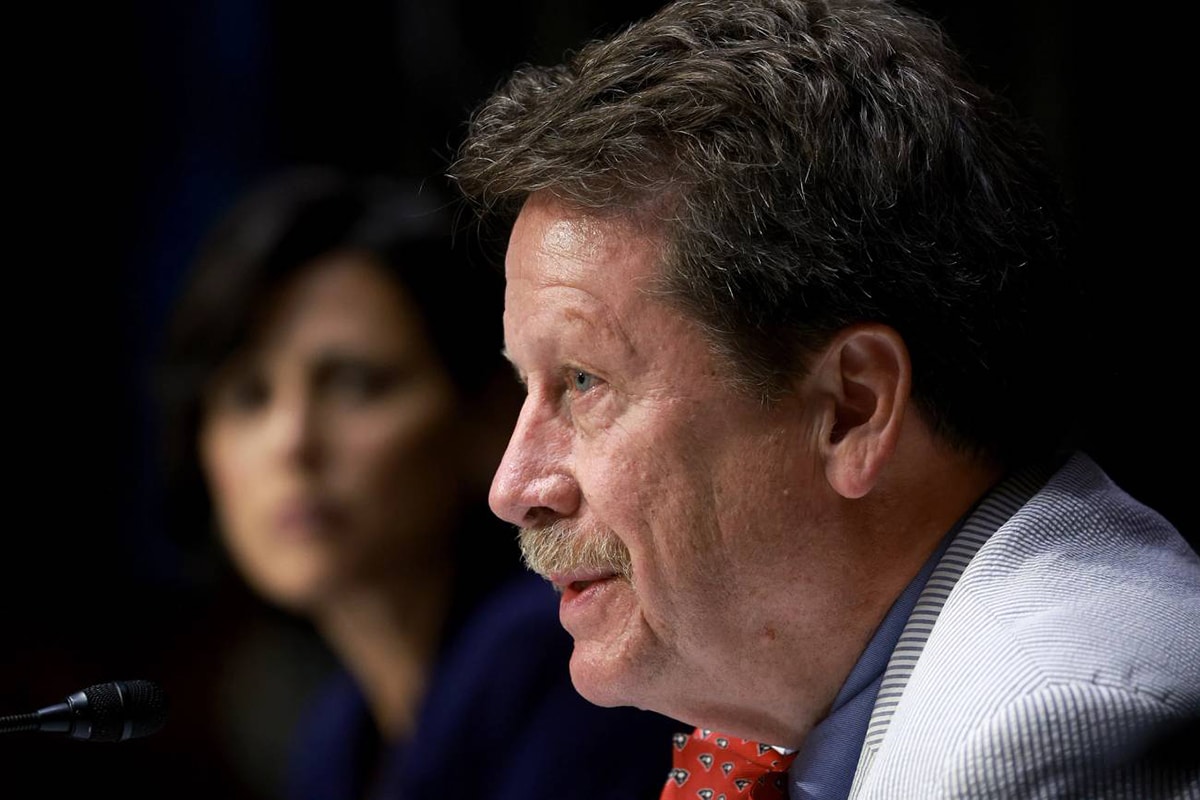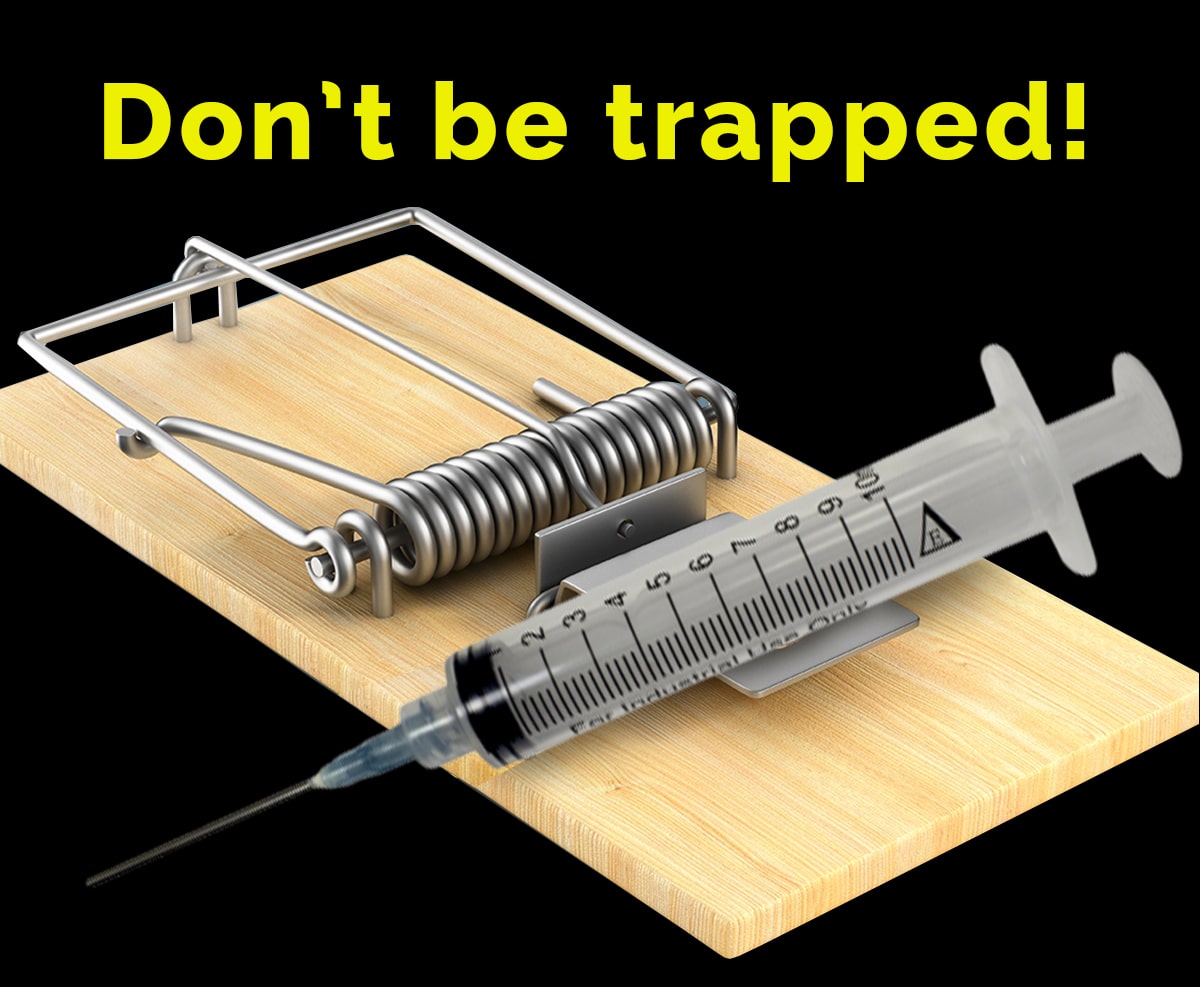

FDA Commissioner Robert Califf and CDC Director Rochelle Walensky speak at the COVID Federal Response Hearing on Capitol Hill in Washington, D.C., on June 16, 2022JOE RAEDLE/GETTY IMAGES
Drug Companies Test New Booster on Eight Mice and Zero Humans, FDA Approves It Anyway
by Alex Gutentag | Sep 18, 2022
On Aug. 31, 2022, the Food and Drug Administration authorized bivalent boosters reformulated to target the BA.4 and BA.5 omicron subvariants. At the authorization meeting, FDA officials announced the approval of these new boosters for emergency use based on data from eight mice in a Pfizer study. At the same time, the FDA revoked authorization for the original monovalent boosters—meaning anyone subject to a booster or “up-to-date” mandate will have to take the bivalent booster, which has no proven safety or efficacy data in human beings.
While the flu vaccine is also approved on a yearly basis without full trials, the mRNA COVID vaccines do not share the flu shot’s decadeslong track record of observed safety. The population most likely to be mandated to take a bivalent booster consists largely of college students. The young men in this population are the exact demographic that face heightened safety concerns, specifically around myocarditis, as documented in multiple peer-reviewed studies. In fact, during a meeting of the Centers for Disease Control and Prevention to recommend the bivalent boosters, the agency presented updated myocarditis data that confirmed the rates of myocarditis in young men were about 2-to-3.5 times higher (slide 35) than the agency had claimed last year (slide 13). Nevertheless, the FDA and CDC moved to recommend the bivalent boosters for anyone over the age of 12 without human clinical trials.
This is just the latest episode in the FDA’s less-than-thorough approach to new COVID vaccine approvals. For example, in May 2022, the FDA authorized monovalent Pfizer boosters for children ages 5-11 based on laboratory data that showed heightened antibody response levels in just 67 children.
During the opioid crisis, the FDA famously failed to demand adequate research, disregarded safety concerns, and allowed Purdue Pharma to promote oxycodone for uses that were never borne out by testing. Later, it was revealed that the agency had been plagued by ethical issues: When the FDA convened advisers to address mounting oxycodone safety concerns, for instance, five out of 10 of these advisers had received payments from Purdue, and another three had received payments from other opioid manufacturers.
The continuation of unchecked conflicts of interest, and several recent authorizations for uses of new medical products that are in many ways unproven, demonstrate that the FDA is essentially unresponsive to public outrage, culminating in the bizarre spectacle of the agency promoting bivalent boosters on social media through unsubstantiated claims of efficacy, acting not as a neutral regulator but actively advertising on behalf of pharmaceutical companies with government purchase contracts. The FDA’s disregard for its congressional mandate is not unique to this moment—it is a symptom of its decadeslong transformation into an agency captured by the corporations it is tasked with regulating.
When Kelley Krohnert, a mother and career IT expert from Georgia, watched the CDC’s Advisory Committee on Immunization Practices meeting held on June 17, 2022, she noted a slide that listed COVID as the fourth-leading cause of death for children under 1 and the fifth-leading cause for children aged 1-4 in the United States. This same slide was originally used at the FDA’s June 15 Vaccines and Related Biological Products Advisory Committee (VRBPAC) meeting, when FDA advisers voted to authorize vaccines for children under 5. Krohnert immediately recognized that the slide was citing a preprint by researchers in the United Kingdom. This preprint not only used death statistics that included deaths where COVID was not an underlying cause—it also compared a 26-month cumulative total for COVID deaths to a 12-month total for other deaths. In Krohnert’s analysis, COVID fell to ninth place for children under 1 and into a four-way tie for eighth place for children aged 1-4. When the researchers corrected their preprint to adjust for some of the errors Krohnert found, COVID fell below influenza and pneumonia as a cause of death for children under 5.
“I didn’t have to do a complex statistical analysis to find these errors,” Krohnert told me. “If this is the standard for what goes into these presentations, what kind of vetting is going into that data?”
This lack of vetting is a central issue in the FDA’s approval process. The key question for any drug authorization is, “Do the benefits outweigh the risks?” When a disease’s risks are exaggerated, one side of this equation is skewed, and the equation is also affected by exaggerating the benefits of a treatment or ignoring the potential risks of that treatment. The data presented in recent FDA meetings has been consistently nonobjective and skewed to favor drug approval.
For the authorization of vaccines for children under 5, boosters for children 5-11, and the new bivalent boosters, the FDA has relied heavily on measures of antibody levels as the main “benefit” side of the equation. This is despite the fact that Pfizer has admitted that there is “no established correlate of protection” between antibody levels and immunity. Both the CDC and the FDA already advise against the use of antibody testing to determine levels of immunity. Essentially, this metric has been deemed inadequate by the very regulatory agency that is now consistently accepting it as a substitute for clinical trials.
This lack of real efficacy data has been accompanied by a disregard for potential safety issues. European Union regulators have already warned that frequent boosters can weaken the immune system; the FDA is apparently unconcerned. The FDA also disregarded the fact that for pediatric vaccines, Pfizer observed a higher rate of severe COVID in its vaccine group (table 5). Furthermore, the FDA allowed the company to ignore 365 symptomatic cases in its trial, and to use only the last 10 symptomatic cases after the third dose to claim 80% efficacy (tables 19 and 20). This is significant because Pfizer saw negative efficacy between doses 1 and 2. In a vaccine meant to prevent illness for an age group that is already at extremely low risk, this data should have been a red flag for the FDA. Why, then, has the body charged with protecting Americans from inadequately tested products been so eager not just to authorize these products for emergency use, but to enthusiastically recommend them?
Dr. Paul Offit, director of the Vaccine Education Center and attending physician in the Division of Infectious Diseases at Children’s Hospital of Philadelphia, was one of only two advisers who voted against VRBPAC’s recommendation for reformulated boosters in June. I asked him about his vote as an FDA vaccine adviser and longtime advocate for vaccination. He told me he believed the thinking behind the bivalent boosters was sound. “The problem for me,” he said, “was I just didn’t think the data that were presented on June 28th to our committee made that case compellingly.”
I asked Offit if he felt there was political pressure to vote a certain way. “I never feel pressure when I cast my vote,” he answered. “I voted no.” However, he said, “I think the way that they were presented, I think it was clear that the FDA and the World Health Organization wanted to go in this direction.” It was notable that the day after the FDA’s vote, the White House announced its purchase of 171 million bivalent booster doses from Pfizer and Moderna for $4.9 billion. “You felt that the train sort of had left the station,” Offit said.
In 2020, the Trump administration was widely criticized for rushing vaccines and pressuring the FDA. Although the Biden administration has exerted similar, if not more pressure, it has enjoyed a conspicuous absence of criticism. Before the FDA’s expert panel could even meet to discuss vaccines for children under 5, for example, the White House’s COVID czar, Ashish Jha, publicly announced a precise date for when they would become available. In other words, Jha appeared to know the FDA’s decision before it had allegedly made one.
Notably, President Joe Biden’s election campaign reversed a long-standing trend of Republican candidates receiving far more campaign donations from the pharmaceutical industry: In 2020, Biden outraised Trump from Big Pharma by a margin of 2 to 1. Several political appointees in the Biden administration, moreover, have ties to vaccine manufacturers, including the president’s chief campaign strategist, Anita Dunn, who worked for Pfizer before joining his team. Biden also ran his election campaign on the promise to “shut down the virus”; it turned out that there were more U.S. COVID deaths in 2021, when vaccines were widely available, than in 2020, when they were not. Rather than reckon with this fact and readjust its strategy, the administration has doubled down by putting increased political pressure on an already compromised FDA.
If your primary job occupation is to work for the firm across the table, how can you be an effective regulator?
The public comment section of the June 15, 2022, VRBPAC meeting featured several anxious parents who described keeping their infants and toddlers under extreme conditions of isolation, over two years after the the beginning of the pandemic. Many FDA panelists argued that, in light of these comments, it was necessary to authorize the vaccines so that these parents could finally allow their infants and toddlers to experience normal life.
“That’s just not an acceptable basis for drug or vaccine authorization,” Dr. Vinay Prasad, professor of epidemiology and biostatistics at the University of California, San Francisco, told me. The purpose of the FDA as a federal regulatory agency is not to simply give people choices, or even to address consumer anxiety as such. The FDA’s focus on parents’ desires as a rationale for approval is particularly significant given that just 5% of children under 5 ended up getting the first dose. Clearly, the demand has not been overwhelming. If we wanted unlimited options, Prasad explained, we wouldn’t have an FDA at all. “You can just have a free market where you can have whatever choice you want,” he said. The purpose of the FDA, by contrast, is “to shield us from making very, very bad choices.”
The FDA used to have solid credibility on safety and efficacy, but in Prasad’s view, “over the last 15 or 20 years, in many sectors of the FDA, I think there’s been an erosion in fundamental values and an increase in favoritism toward corporate interests.” Pharmaceutical companies have been allowed to provide funding for the FDA since 1992; today, a full 75% of the FDA’s scientific review budget comes directly from the industry. There is also the problem of the FDA’s revolving door. In 2016, Prasad conducted a review of the future jobs of cancer and hematology regulators and found that 57% of those who left the FDA went on to work for the industry. This “is sort of a terribly perverse incentive,” Prasad explained. “If your primary job occupation is to work for the firm across the table, how can you be an effective regulator?”
Currently, some of the FDA advisers who have served on VRBPAC panels have potential conflicts of interest. Dr. James Hildreth, for example, is president and CEO of Meharry Medical College, which served as a site for Moderna’s vaccine trial, and which was set to receive between $1.5 million and $2 million from the pharmaceutical giant. He was granted a waiver to be a voting member on VRBPAC anyway.
The Centers for Medicare & Medicaid Services make public any funding that doctors receive from the biopharmaceutical industry. According to this database, Dr. Arnold Monto, the acting chair of VRBPAC, received a total of $161,350 in payments from pharmaceutical companies between 2015 and 2021. This includes consulting fees from Pfizer, Seqirus (a company that plans to use mRNA technology to develop new influenza vaccines), and Hoffmann-La Roche (the company that provided antibody tests for Moderna’s vaccine trials). Dr. Archana Chatterjee, a member of VRBPAC, received $456,657 in payments and research funding from pharmaceutical companies between 2015 and 2021. This includes $131,657 in payments and research funding from Pfizer, which the FDA apparently did not consider a potential conflict of interest.
Since 2015, at least seven other voting FDA advisers have received thousands (and sometimes tens or hundreds of thousands) of dollars from pharmaceutical companies in the form of consulting fees and research funding. Of these, Dr. Ofer Levy, Dr. Wayne Marasco, Dr. Steven Pergam, and Dr. Jay Portnoy received payments from companies involved in mRNA technology. These companies include Shire, Amgen, Merck, and Boehringer Ingelheim. The fact that some advisers received funding from companies that have previous or new investments in mRNA is made more troubling by the fact that Levy cited the general use of mRNA as a reason to approve pediatric vaccines on June 15. “There’s a broader context,” he said. “This mRNA vaccine platform may be useful not just against this current coronavirus and its current variants, but the next one as well as future pandemics.” In total, of the 21 members at the June 15 meeting (who voted unanimously to recommend vaccines for children under 5), at least 10 had received some form of direct or indirect payment from the biopharmaceutical industry.
These kinds of relationships are not outside the norm. To this day, we don’t know what if any financial incentives were involved in the selection process for companies that received research funding through Operation Warp Speed. This is because Donald Trump’s vaccine chief, Moncef Slaoui, accepted a $1 government contractor fee, which legally allowed him to avoid disclosing his full stock portfolio. Moreover, one of the main architects of Operation Warp Speed was the FDA’s lead vaccine regulator, Dr. Peter Marks. A Star Trek fan, Marks was the man who gave Operation Warp Speed its name. According to Dr. Janet Woodcock, the former interim head of the FDA, “The U.S. response to the pandemic as far as vaccines … was largely [Dr. Mark’s] concept.” Originally, Marks recused himself from a regulatory position, but regained his role once he left Operation Warp Speed, shortly after the program began.
Regardless of the ultimate successes or failures of Operation Warp Speed itself, this raises a fundamental ethical question about how the American government works. If a regulator is personally invested in the success of drug development, can he or she be objective in making regulatory decisions for ordinary people? This question is all the more relevant given the fact that COVID vaccines are some of the most lucrative pharmaceutical products in history.
In 2021, Pfizer’s COVID vaccine sales topped $36 billion and Moderna’s reached $17.7 billion. In 2022, these companies are forecast to reach a combined $51 billion in COVID vaccine sales. It is, of course, in the interests of Pfizer and Moderna to seek to maximize profits by bypassing clinical trials. This is how we would expect these companies to behave. It is the role of the FDA, however, to ensure that any product on the market is effective and safe.
As we learned during the opioid epidemic, a breakdown in the decision-making process at the FDA can have a profound impact on society as a whole. To watch the FDA actively promote a fifth COVID shot for Americans while almost every other country on Earth moves in the opposite direction is to notice that something fundamental remains broken at the agency. Apart from Canada, no other country in the world has approved mRNA shots for children under 5. The U.K. has banned COVID vaccines for healthy children under 12, and several European countries suspended Moderna’s vaccine for anyone under 30.
One recent analysis of adverse event data found that for every 22,000 to 30,000 previously uninfected adults ages 18-29 who get boosted, there will be only one COVID hospitalization prevented. Meanwhile, 18 to 98 serious adverse events will occur. Allowing vaccine manufacturers to forgo clinical trials is thus a negligent betrayal of consumers and taxpayers who continue to trust and rely on the FDA’s stamp of approval.




